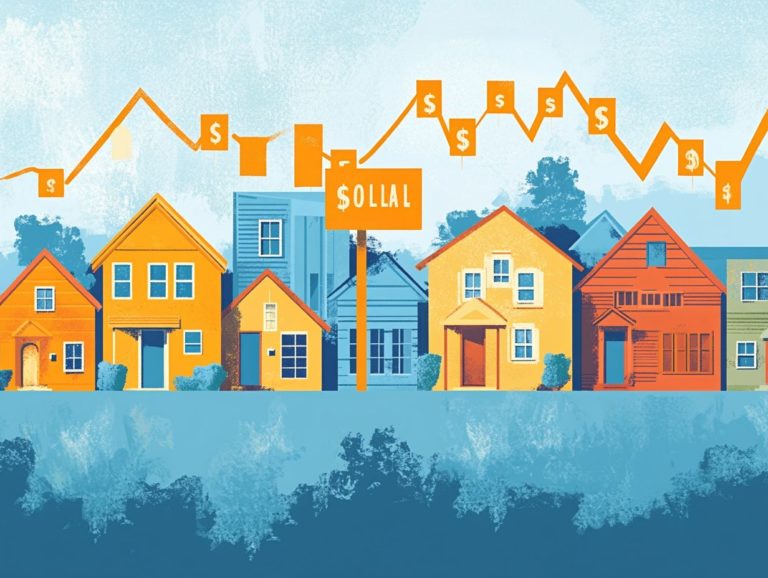Understanding Supply and Demand in Real Estate
Navigating the real estate market can be challenging, but understanding it is key to your success!
This article delves into the key factors that influence the dynamics of supply and demand, including economic conditions, population growth, and interest rates. It examines how fluctuations in these elements directly affect real estate prices and provides strategies for both buyers and sellers in a competitive landscape.
Whether you’re about to purchase your first home or contemplating selling a property, this guide is a treasure trove of insights designed to empower you to make informed decisions.
Contents
- Key Takeaways:
- Defining Supply and Demand
- Factors Affecting Supply and Demand in the Real Estate Market
- Impact of Supply and Demand on Real Estate Prices
- Strategies for Buyers and Sellers in a Competitive Market
- Frequently Asked Questions
- What is supply and demand in real estate?
- How does supply and demand impact real estate prices?
- What factors influence supply and demand in real estate?
- How does understanding supply and demand help in real estate investing?
- How Can Supply and Demand Impact the Rental Market?
- How Can I Stay Informed About Supply and Demand in the Real Estate Market?
Key Takeaways:

Supply and demand are fundamental concepts that drive the real estate market. Economic conditions, population growth, and interest rates greatly influence supply and demand. Buyers and sellers need to understand how these factors affect prices to make informed decisions in a competitive market.
Defining Supply and Demand
Supply and demand in the real estate market are essential economic principles that define the relationship between housing availability and buyers’ eagerness to purchase homes. Understanding this relationship is crucial for grasping the fluctuations in home prices, mortgage rates, and housing supply.
Several factors, including local market conditions and buyer demographics, shape this dynamic. Construction materials also play a role, ultimately leading to market equilibrium, where supply aligns with demand. The COVID-19 pandemic has transformed buyer behavior and inventory levels significantly, making it vital to analyze these shifts within the context of the current economic landscape.
Factors Affecting Supply and Demand in the Real Estate Market
The real estate market is shaped by a multitude of factors that govern supply and demand. These include economic conditions, population growth, and mortgage availability.
Economic principles like inflation and employment rates are pivotal in influencing housing supply and defining buyer demographics. Interest rates and mortgage accessibility also play crucial roles in shaping buyer behavior, whether it s millennials searching for new construction or baby boomers ready to sell their long-held homes.
Grasping these demand factors is essential for navigating local markets with confidence and precision.
Economic Conditions
Economic conditions are a critical factor in determining the landscape of the real estate market. They affect everything from housing prices to the financial health of consumers and the demographics of buyers.
Key indicators like GDP growth and unemployment rates set the stage for an environment that either fosters or dampens housing demand. For example, during times of economic expansion, increased consumer confidence can lead to higher home prices and more aggressive buying behavior.
Recessions can suppress demand, impacting overall housing supply. Fluctuations in interest rates also play a pivotal role in shaping affordability.
When rates are low, you might feel compelled to dive into the market, driving demand and often pushing home prices higher. Conversely, as interest rates rise, you may hesitate, leading to a more competitive landscape where sellers have to rethink their pricing strategies to capture your interest.
Local economic conditions, such as job growth in your area, can cause housing trends to shift. Regions experiencing an influx of employment opportunities often see a surge in demand for homes, driving up property values.
For further assistance or to apply what you ve learned, consider contacting a real estate professional.
Population Growth and Demographics

Population growth and changing demographics impact housing demand. They determine the types of homes buyers want and the communities they choose.
For example, you may have noticed that Millennials are increasingly gravitating toward new home construction in urban areas. Meanwhile, Baby Boomers often desire to downsize, directly affecting the inventory levels of existing homes.
These trends highlight how the distinct needs of different generations shape the real estate landscape. Developers are prompted to focus on creating more multifamily dwellings or accessible single-level homes.
Younger buyers prioritize walkable neighborhoods with convenient amenities. In contrast, older generations place greater emphasis on safety and proximity to healthcare services.
By remaining attuned to these evolving preferences in housing options, real estate professionals can proactively address the challenges posed by a constantly shifting buyer demographic. This ensures offerings are closely aligned with current market demands.
Interest Rates and Mortgage Availability
Interest rates and mortgage availability play a crucial role in shaping your ability to access homes. They significantly influence housing supply and home prices.
When interest rates are low, borrowing becomes more affordable. This often results in heightened housing demand and a subsequent increase in home prices.
On the flip side, when interest rates climb, mortgage availability can tighten. This dampens your enthusiasm to buy and disrupts the overall market balance.
This dynamic creates a ripple effect throughout the economy. You might find yourself delaying a purchase when rates rise, leading to fewer transactions in the market.
As demand decreases, it can create an oversupply of homes, putting downward pressure on prices. Builders may respond by scaling back new construction, ultimately limiting the availability of homes in the future.
Understanding how interest rates influence buyer behavior is essential for grasping market activity and assessing the health of the real estate sector.
Impact of Supply and Demand on Real Estate Prices
The interaction of supply and demand profoundly influences real estate prices. Market equilibrium is reached when housing supply aligns with buyer demand.
Fluctuations in these factors can lead to substantial shifts in housing prices, as evidenced by various local markets across the U.S. Grasping the sensitivity of prices to supply and demand changes is essential.
When demand surges, prices typically rise. Conversely, an oversupply can trigger notable price declines. This dynamic shifts the strategic landscape for both buyers and sellers.
A keen understanding of market trends is required to navigate effectively.
How Changes in Supply and Demand Affect Prices
Changes in supply and demand can quickly reshape housing prices. Stay alert; a sudden shift can mean the difference between finding your dream home and losing it to someone else!
For instance, when new home construction boosts housing supply, prices may drop if demand doesn’t keep up.
On the flip side, a surge in demand whether due to favorable economic conditions or low interest rates can send prices soaring. This highlights the delicate balance of economic principles at play in the real estate market.
Take cities undergoing a tech boom, for example. A sudden influx of jobs can significantly elevate demand, driving prices upward as potential homeowners vie for limited listings.
Conversely, in regions facing economic downturns like when factories shut down or major employers relocate the housing market might see an oversupply of homes. This shift can lead to a decrease in prices, forcing sellers to lower their asking prices just to attract buyers.
These scenarios vividly illustrate how local market behaviors are influenced by broader economic trends. Stakeholders must adapt their strategies to successfully navigate the ever-evolving landscape of real estate.
Strategies for Buyers and Sellers in a Competitive Market

In a real estate market, you must employ effective strategies to navigate the complexities of housing demand and supply.
As a buyer, understanding your demographics and the types of homes available can greatly influence your purchasing decisions.
If you’re a seller, being aware of current market trends and buyer preferences is crucial. This knowledge allows you to position your property effectively, ensuring that you attract the right audience in a challenging landscape.
Tips for Buyers
In a competitive real estate market, adopt savvy buyer strategies to navigate the ever-changing landscape of housing demand and mortgage rates.
Stay alert on mortgage rates they can make a big difference to your budget! Understanding market trends and current inventory levels helps you make informed decisions and negotiate better terms.
Look into all available inventory, including hidden properties not yet on the market. You could discover remarkable opportunities.
Being aware of favorable market conditions, such as seasonal trends or shifts in buyer demographics, enhances your chances of securing your ideal home. With careful planning and research, position yourself as a serious contender, ready to act when the perfect opportunity arises.
Tips for Sellers
As a seller, embrace strategies that align with current housing supply and market trends to attract potential buyers.
- Set a competitive price and stage your home to enhance its appeal, often leading to quicker sales.
- Keep an eye on local market conditions to adjust your pricing strategy.
- Use digital marketing techniques like high-quality photos and virtual tours to reach a broader audience.
- Host strategic open house events to create excitement and urgency among buyers.
- Never underestimate curb appeal; simple landscaping or exterior updates can leave a lasting impression.
- Time your listing to coincide with peak buying seasons to maximize visibility.
Frequently Asked Questions
What is supply and demand in real estate?

Supply and demand in real estate means how many homes are available compared to how many buyers want them. It’s a key factor that affects property prices and the overall health of the real estate market.
How does supply and demand impact real estate prices?
The basic principle of supply and demand states that when supply is low and demand is high, prices tend to increase. When there are fewer properties available and more buyers in the market, prices will rise. Conversely, when supply is high and demand is low, prices typically decrease.
What factors influence supply and demand in real estate?
Various factors impact the supply and demand in the real estate market, including population growth, economic conditions, interest rates, consumer confidence, and government policies. The location, condition, and type of property also affect supply and demand.
How does understanding supply and demand help in real estate investing?
As an investor, understanding supply and demand can help you make informed decisions about when and where to buy or sell properties. By analyzing market trends and supply-demand dynamics, you can identify potential investment opportunities and make more strategic decisions.
How Can Supply and Demand Impact the Rental Market?
Curious about how supply and demand shape the rental market? When demand for rental properties is high and few are available, landlords can charge higher rents.
Conversely, when there are many rental properties but few tenants, landlords may need to lower rents to attract renters.
How Can I Stay Informed About Supply and Demand in the Real Estate Market?
To stay updated on supply and demand, regularly check market data and trends. Monitor housing inventory and track buyer interest.
Stay tuned to economic changes and demographic trends, as these can greatly impact the market. A reliable real estate agent or industry expert can also offer valuable insights.






